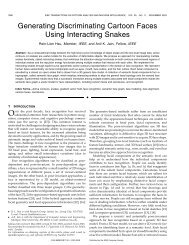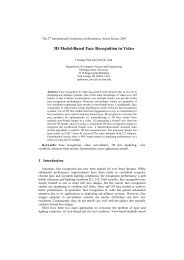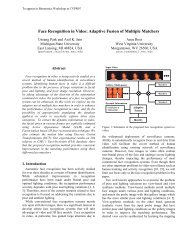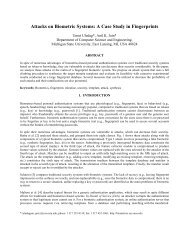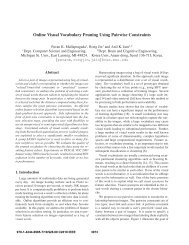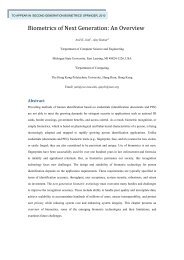Face Detection and Modeling for Recognition - Biometrics Research ...
Face Detection and Modeling for Recognition - Biometrics Research ...
Face Detection and Modeling for Recognition - Biometrics Research ...
Create successful ePaper yourself
Turn your PDF publications into a flip-book with our unique Google optimized e-Paper software.
(a) (b) (c)<br />
Figure 5.1. Semantic face graph is shown in a frontal view, whose nodes are (a)<br />
indicated by text; (b) depicted by polynomial curves; (c) filled with different shades.<br />
The edges of the semantic graph are implicitly stored in a 3D generic face model <strong>and</strong><br />
are hidden here.<br />
regions. The vertices at the top level are labelled with facial components such as the<br />
face outline, eyebrows, eyes, nose, <strong>and</strong> mouth (see Fig. 5.2). Let T 0 denote the set of<br />
all semantic facial components, which are nodes of the generic semantic graph, G 0 .<br />
That is T 0 = {{left eyebrow}, {right eyebrows}, {left eye},..., {hair boundary}}. Let<br />
T be a subset of T 0 , that is T ⊂ 2 T 0<br />
. Let M be the number of facial components<br />
in T . For example, T can be specified as {{left eye}, {right eye}}, {mouth}}, where<br />
M is 3. Let the semantic graph projected on a 2D image, represented by the set<br />
T, be G. The coordinates of component boundary of G can be represented by a<br />
pair of sequences x i (n) <strong>and</strong> y i (n), where n = 0, 1, . . . , N i − 1 <strong>and</strong> i = 1, . . . , M, <strong>for</strong><br />
component i with N i vertices. The 1D Fourier trans<strong>for</strong>m, a i (k), of the complex signal<br />
u i (n) = x i (n) + jy i (n) (where j = √ −1) is computed by<br />
a i (k) = F{u i (n)} =<br />
N∑<br />
i −1<br />
n=0<br />
113<br />
u i (n) · e −j2πkn/N i<br />
, (5.1)



